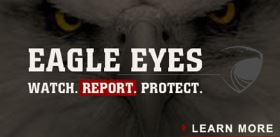 Donated by Mrs. Clara Wietrzak 2005.125.38
Donated by Mrs. Clara Wietrzak 2005.125.38 The U.S. military has traditionally shied away from incorporating darker images of heraldry into its patches and insignia.
The main exception, however, are the World War II Marine Raiders and their use of the skull.
Col Evans Carlson’s 2d Raider Battalion first used an unofficial skull with crossed cutlasses as its unofficial battalion logo and calling card. It was influential in the adaption of the Marine Raider Regiment shoulder patch. The design is still used in various ways by Marines in the U.S. Special Operations Command (MARSOC) today. Other, lesser known units have also appropriated skulls for their unofficial unit insignia.
In the Halloween spirit of their darker heraldry, the following are artifacts from the Museum’s collection that feature skulls in their design.
World War II Raider Battalion Member Ring
This ring belonged to PFC Ted Dougherty, a former member of the 1st Raider Battalion. When the Raider Regiment disbanded in early 1944, Dougherty transferred to the newly formed 2d Battalion, 27th Regiment, which was part of the 5th Marine Division and fought in the Battle of Iwo Jima.
The skull and crossbones on the face of this ring reference the design of the Marine Raider Regiment patch insignia. The design was later adopted into insignia for MARSOC, activated 20 June 2003, and is still used today!
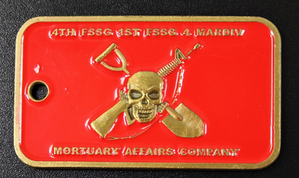 Donated by CWO4 Cheryl Ites, USMC, Ret. 2015. 25.1
Donated by CWO4 Cheryl Ites, USMC, Ret. 2015. 25.1 This challenge coin was one of a limited number that was commissioned by CWO4 Cheryl Ites. She served as the staff non-commissioned officer for the Mortuary Affairs Company Detachments 3, 4 and 5 during Fallujah II and Operation Al-Fajr in 2004.
The coins were given to individuals who went above and beyond for the Mortuary Affairs Marines. The front features a crest with an image of a rifle and shovel crossed behind a skull located in the center of the design. The shovel stands for the Mortuary Affairs Marines. Ites stated that the design was a statement that Marines are always riflemen first and are their own first line of defense. It illustrates the mantra of the U.S. Marine Corps: we take care of our own. The design was later incorporated into an unofficial guidon for the Mortuary Affairs Marines.
During the Second Battle of Fallujah, Operation Al-Fajr and Operation Phantom Fury, the Personnel Retrieval Platoon (PRP) and Mortuary Affairs Platoons were responsible for the recovery of dead remains that included U.S. military, enemy, quasi-insurgents, and civilians. In accordance with the Geneva Convention, the U.S. military personnel are required to recover remains of enemy and civilians killed in action during battle. PRP Marines have some of the most emotionally charged and stressful jobs. The Mortuary Affairs teams worked closely with combat forces to ensure enemy bodies were handled appropriately in accordance with Islamic customs, carefully recovering the bodies, transporting them, and ensuring the remains were buried in compliance with religious traditions.
In 2004, there were five Marine Corps Mortuary Affairs Detachments serving in Iraq:
Detachment 1 - Al Taqaddum
Detachment 2 - Al Asad
Detachment 3 - An Najaf
Detachment 4 - Fallujah
Detachment 5 - Camp Fallujah
Detachments 2, 3, and 5 were responsible for the recovery of United States Marine remains from the Battle of Fallujah. Detachments 1 and 4 were responsible for recovery of enemy, quasi-insurgents, and civilian remains.
This unofficial guidon was made for Detachments 1 and 4, with both sides displayed at one time or another. Detachment 1 often displayed the “Nec Metus De Morte - No One is Left Behind We Do Not Fear Death” side, while Detachment 4 displayed the “Mortuary Affairs Semper Fidelis” side. The non-standard, non-regulation colors used caused the Detachments some flack when the guidon was displayed outside their command posts. As a result, Detachment 4 moved the guidon from in front of the facility in which it worked, to inside the “office” space.
The guidon’s design is specific to Mortuary Affairs Marines. It has a black background and incorporates the USMC organizational flag colors for the embroidered design elements. One side features the traditional Marine Corps eagle, globe, and anchor with the words, “SEMPER FIDELIS,” Latin phrase for “Always Faithful.“ The other side has a different design, “Nec Metus De Morte” embroidered above, and “We Do Not Fear Death” below a center design element of a crossed rifle and shovel positioned behind a skull. The shovel in the design illustrates the Mortuary Affairs Marines, while the rifle is used to illustrate that “Every Marine is a rifleman” first.
The guidon was created to illustrate how the eagle, globe, and anchor, the skull and shovel along with the statement “No One Left Behind” resonates with the mantra of the U.S. Marine Corps: Marines take care of their own.
This T-shirt was designed by GySgt Rene Avendano for the 1st Battalion, 23rd Marine IED (Improvised Explosive Device) Detection Dog (IDD) dog handlers. The T-shirt was part of a larger collection of items donated to the Museum that document IDD dog handlers who served in Al Anbar Province, Afghanistan, in 2004. IDD dogs were used to detect hidden explosives and IEDs. Dogs chosen for the program were usually bloodline Labrador Retrievers or other hunting breeds. The dogs were trained to identify and alert key elements found in explosives.
 Transferred from HMH-461 2016.19.3
Transferred from HMH-461 2016.19.3 Marine Heavy Helicopter Squadron 461 (HMH-461) traces its lineage to World War II.
In January 2008, the squadron deployed to provide support missions in Afghanistan, support operations in the Horn of Africa, as well as in 2010 for relief efforts in Haiti during Operation United Response. More recently, a detachment of four HMH-461 CH-46E Super Stallions supported the Special Purpose Marine Air-Ground Task Force Southern Command (SPMAGTF-SC).
The patch here was created for the flight crews which participated in the SPMAGTF-SC deployment in the summer of 2015. The design features “Baron Samedi,” a Loa or figure from Haitian voodoo religion, and considered a mysterious and dangerous spirit known for debauchery, smoking, and drinking. An ace of spades card has been added to the Baron’s top hat, denoting the Air Combat Element of the SPMAGTF-SC.

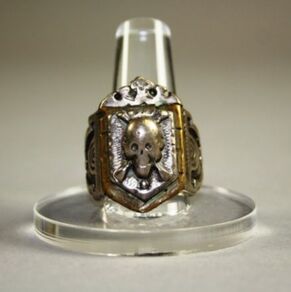


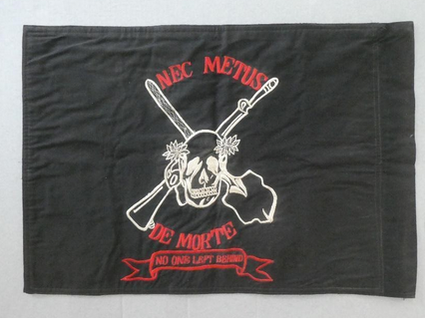
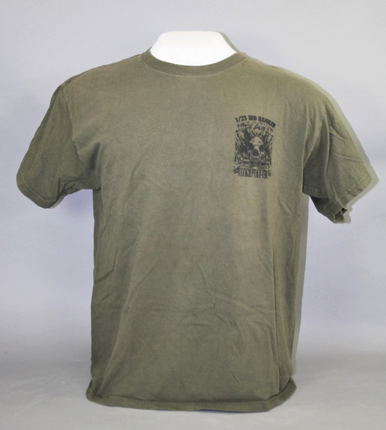
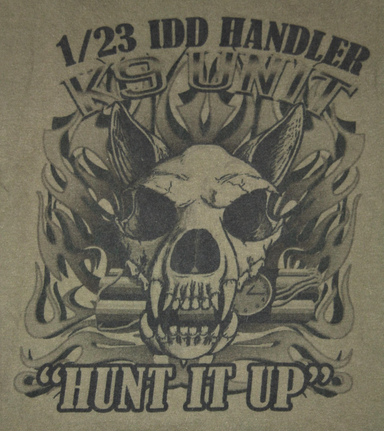
 RSS Feed
RSS Feed


